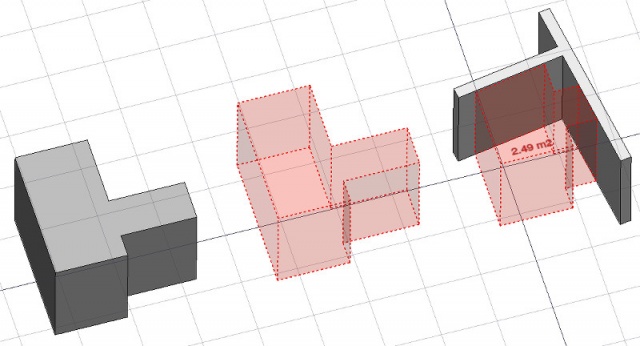Architektura: Kubatura
|
|
| Lokalizacja w menu |
|---|
| Architektura → Przestrzeń |
| Środowisko pracy |
| Architektura |
| Domyślny skrót |
| S P |
| Wprowadzono w wersji |
| 0.14 |
| Zobacz także |
| Ściana, Konstrukcja |
Opis
Narzędzie Przestrzeń pozwala zdefiniować pustą objętość, opierając ją na bryle, definiując jej granice lub łącząc oba te sposoby. Jeśli jest on oparty wyłącznie na granicach, objętość jest obliczana poprzez rozpoczęcie od obwiedni wszystkich podanych granic i odjęcie przestrzeni za każdą z nich. Obiekt Przestrzeń zawsze definiuje objętość bryły. Można również wyświetlić powierzchnię podłogi obiektu przestrzeni, obliczoną przez przecięcie płaszczyzny poziomej w środku masy objętości przestrzeni.
Space object created from an existing solid object, then two wall faces are added as boundaries.
Usage
- Select an existing solid object, or faces on boundary objects.
- Invoke the Arch Space command using several methods:
- Pressing the
Arch Space button in the toolbar.
- Using the S then P keyboard keys
- Using the Arch → Space entry from the top menu
- Pressing the
Limitations
- The boundaries properties is currently not editable via GUI.
- See the forum announcement.
Properties
- DANEBase: The base object, if any (must be a solid)
- DANEBoundaries: A list of optional boundary elements
- DANEArea: The computed floor area of this space
- DANEFinishFloor: The finishing of the floor of this space
- DANEFinishWalls: The finishing of the walls of this space
- DANEFinishCeiling: The finishing of the ceiling of this space
- DANEGroup: Objects that are included inside this space, such as furniture
- DANESpaceType: The type of this space
- DANEFloorThickness: The thickness of the floor finish
- DANENumberOfPeople: The number of people who typically occupy this space
- DANELightingPower: The electric power needed to light this space in Watts
- DANEEquipmentPower: The electric power needed by the equipment of this space in Watts
- DANEAutoPower: If True, Equipment Power will be automatically filled by the equipment included in this space
- DANEConditioning: The type of air conditioning of this space
- DANEInternal: Specifies if this space is internal or external
- WIDOKText: The text to show. Use $area, $label, $tag, $floor, $walls, $ceiling to insert the respective data
- WIDOKFontName: The name of the font
- WIDOKTextColor: The color of the text
- WIDOKFontSize: The size of the text
- WIDOKFirstLine: The size of the first line of text (multiplies the font size. 1 = same size, 2 = double size, etc..)
- WIDOKLineSpacing: The space between the lines of text
- WIDOKTextPosition: The position of the text. Leave (0,0,0) for automatic position
- WIDOKTextAlign: The justification of the text
- WIDOKDecimals: The number of decimals to use for calculated texts
- WIDOKShowUnit: Show the unit suffix or not
Options
- To create zones that group several spaces, use an Arch BuildingPart and set its IFC type to "Spatial Zone".
- The Space object has the same display modes as other Arch and Part objects, with one more, called Footprint, that displays only the bottom face of the space.
Scripting
See also: Arch API and FreeCAD Scripting Basics.
The Space tool can be used in macros and from the Python console by using the following function:
Space = makeSpace(objects=None, baseobj=None, name="Space")
- Creates a
Spaceobject from the givenobjectsorbaseobj, which can be- one document object, in which case it becomes the base shape of the Space object, or
- a list of selection objects as returned by
FreeCADGui.Selection.getSelectionEx(), or - a list of tuples
(object, subobjectname)
Example:
import FreeCAD, Arch
Box = FreeCAD.ActiveDocument.addObject("Part::Box", "Box")
Box.Length = 1000
Box.Width = 1000
Box.Height = 1000
Space = Arch.makeSpace(Box)
Space.ViewObject.LineWidth = 2
FreeCAD.ActiveDocument.recompute()
After a space object is created, selected faces can be added to it with the following code:
import FreeCAD, FreeCADGui, Draft, Arch
points = [FreeCAD.Vector(-500, 0, 0), FreeCAD.Vector(1000, 1000, 0)]
Line = Draft.makeWire(points)
Wall = Arch.makeWall(Line, width=150, height=2000)
FreeCAD.ActiveDocument.recompute()
# Select a face of the wall
selection = FreeCADGui.Selection.getSelectionEx()
Arch.addSpaceBoundaries(Space, selection)
Boundaries can also be removed, again by selecting the indicated faces:
selection = FreeCADGui.Selection.getSelectionEx()
Arch.removeSpaceBoundaries(Space, selection)
- Elementy: Mury, Konstrukcja, ściana kurtynowa, Okna, Drzwi, Dach, Kubatura, Schody, Wyposażenie, Ramy, Ogrodzenie, Kratownica, Profil, Rura, Kształtka
- Zbrojenie: Pręty zbrojeniowe proste, Pręty zbrojeniowe typu U, Pręty zbrojeniowe typu L, Strzemiona, Strzemiona, Pręty zbrojeniowe spiralne, Zbrojenie słupów, Zbrojenie belek, Zbrojenie płyt stropowych, Zbrojenie stóp fundamentowych, Pręt zbrojeniowy
- Panels: Panel, Panelizacja do cięcia, Arkusz panela, Zagnieżdżanie
- Materiał: Wybór materiału, Materiał złożony
- Organizacja: Część budowli, Projekt, Teren, Budowla, Piętro, Odniesienie, Płaszczyzna przekroju, Obmiar
- Osie: Osie, Układ osi, Siatka
- Modifikacja: Płaszczyzna cięcia, Komponent dodaj, Komponent usuń, Przegląd
- Narzędzia: Komponent, Klonuj komponent, Podziel siatkę, Siatka na kształt, Zaznacz siatki nie bryłowe, Usuń kształt., Zamknij otwory, Połącz ściany, Sprawdź, Przełącz flagę Brep IFC, Trzy widoki, Arkusz kalkulacyjny IFC, Przełącz widoczność odjęcia
- Dodatkowe: Preferencje, Ustawienia Importu i Eksportu (IFC, DAE, OBJ, JSON, 3DS); SHP), Architektura: API
- Jak zacząć
- Instalacja: Pobieranie programu, Windows, Linux, Mac, Dodatkowych komponentów, Docker, AppImage, Ubuntu Snap
- Podstawy: Informacje na temat FreeCAD, Interfejs użytkownika, Profil nawigacji myszką, Metody wyboru, Nazwa obiektu, Edytor ustawień, Środowiska pracy, Struktura dokumentu, Właściwości, Pomóż w rozwoju FreeCAD, Dotacje
- Pomoc: Poradniki, Wideo poradniki
- Środowiska pracy: Strona Startowa, Architektura, Assembly, CAM, Rysunek Roboczy, MES, Inspekcja, Siatka, OpenSCAD, Część, Projekt Części, Punkty, Inżynieria Wsteczna, Robot, Szkicownik, Arkusz Kalkulacyjny, Powierzchnia 3D, Rysunek Techniczny, Test Framework
